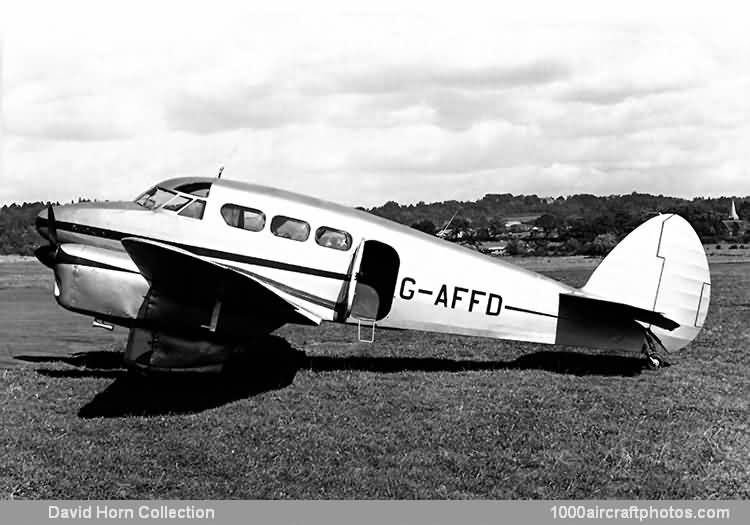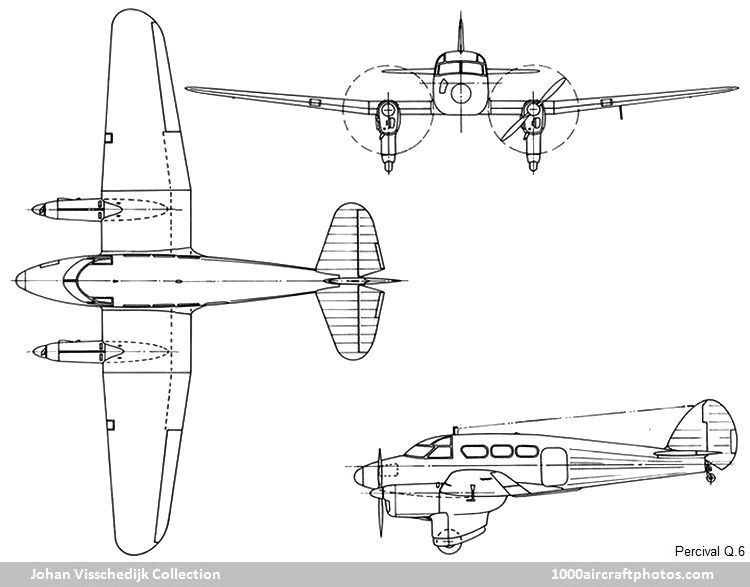07/31/2014. Remarks by Johan Visschedijk: "Designed by Edgar W. Percival in 1936 to carry two crew and four passengers, the Q.6 marked the entry of Percival Aircraft Ltd. into the twin engined market. The fuselage was basically a plywood box faired with fabric over external frames and stringers, and the cantilever wing consisted of two wooden box spars with spruce ribs and plywood skin. Percival split trailing edge flaps were fitted, all control surfaces were fabric covered and the nacelles, integrated with the trousered landing gear, housed 205 hp de Havilland Gipsy Six series II engines driving de Havilland variable pitch airscrews.
The prototype, G-AEYE (c/n Q.20), was first flown at Luton by E.W. Percival on September 14, 1937, the construction of 26 production aircraft commencing in the following year, nine being sold initially for executive use and scheduled services at home. Sir Phillip Sassoon took delivery of G-AFFD, the grey and silver first production aircraft, at Lympne on March 2, 1938. During the next 12 months G-AFFE (c/n Q.23) went to H.B. Legge and Sons Ltd. at Warlingham; G-AFHG (c/n Q.26) to Lord Londonderry, Newtownards; G-AFIW (c/n Q.30) to Vickers Aviation Ltd. at Brooklands; G-AFGX (c/n Q.27) to Intava; G-AFKG (c/n Q.32) to L.A. Hordern, Hatfield; and G-AFKC (c/n Q.33) to Almaza, Cairo, for Lt.-Col. E.T. Peel.
A retractable landing gear was an optional extra, only four aircraft being so fitted. First of these, VH-ABL (c/n Q.25), built to the order of the famous Australian pilot and navigator Captain P.G. Taylor, was involved in an accident during landing gear trials at Martlesham in June 1938, but was not delivered in Australia. On January 2, 1939 the aircraft was registered to Percival Aircraft as G-AFMT, repaired and fitted with a fixed landing gear it was registered to Vickers-Armstrongs Ltd. on June 26, 1939. The second, G-AFIX (c/n Q.31), delivered to W.A.H.B. Burnside at Croydon on December 12, 1938, carried the red and blue livery of Western Airways Ltd. on the Castle Bromwich-Whitchurch-Weston~Cardiff route during the summer of 1939. A third, G-AFMV (c/n Q.37), became the personal aircraft of Viscount Forbes in March 1939 and the fourth was shipped to Australia.
In June 1939 Western Airways Ltd. added to its fleet G-AFVC (c/n Q.24), which had been delivered under French marks a year earlier to Baron L. de Armella. With one exception the civil Q.6s all served in the RAF during WW II, the prototype inaugurating the process on March 6, 1940, when it flew away from Luton, serialed X9328.
Three days later, P5640, last of seven Q.6s built under Air Ministry contract, was delivered to No. 36 M.U. Sealand for RAF communications duties. Impressments came to an end in May 1940, when G-AFVC, flown since the previous September in all yellow color scheme with small black markings on the rear fuselage, departed from Weston to become AX860. The Vickers hack G-AFIW retained its civil status throughout hostilities and although transferred to J. Brockhouse and Co. Ltd. at Minworth in 1943 and damaged in an accident in Corsica in 1945, it survived to become Lt. Cdr. R.E. Bibby's private aircraft in 1946.
The return of peace witnessed the reappearance of four other Percival Q.6s, including the prototype, restored by Southern Aircraft (Gatwick) Ltd. and named 'Southernaire'; G-AFFD operated by the Yorkshire Aeroplane Club at Sherburn-in-Elmet until sold in April 1952 to Walter Instruments Ltd., Redhill; and AFIX demobilized with a fixed landing gear. The last was mainly used by Fremantle Overseas Radio Ltd., but ended its career in 1949 as a taxi and joyriding aircraft with Starways Ltd. at Speke.
Not unexpectedly, three RAF Q.6s also survived to be converted for civilian use by Whitney Straight Ltd. at Weston-super-Mare in 1946. One, formerly P5637 of the Woodley Communications Flight, originally delivered on August 18, 1939, went to Denham as G-AHOM (c/n Q.42) and carried out several long-distance charters to Italy and North Africa piloted by A.R. Lewis of Airways Individual Reservations Ltd. Following a crash landing at Jury's Gap, Dungeness, when flying from Le Bourget to Lympne in bad visibility on Christmas Eve 1946, it returned to Weston for reconstruction. It then went on to enjoy a useful life with the Yellow Air Taxi Co. (Midlands) Ltd. at Elmdon in 1947, with Ductility Steels Ltd., Wolverhampton, with the name 'Ductility' in 1948, with W.J. Twitchell at Luton in 1950, and with its originator E.W. Percival during the EP.9 production in 1956.
After the war the last production Q.6, P5640, originally delivered to No. II Group Station Flight at Northolt on June 2, 1939, was civilianized as G-AHTA (c/n Q.46) for the London and Oxford Steel Co. Ltd. The same firm acquired G-AHTB (c/n Q.39), formerly P5634, but both aircraft were comparatively short lived. G-AHTA, sold to the Brussels taxi firm COGEA in November 1946, was damaged beyond repair in 1954, while G-AHTB went into executive use at Southend with S.E. Norman, only to meet a similar fate at Almaza."

